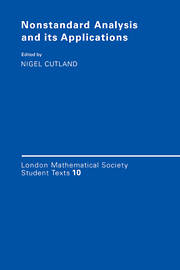Book contents
- Frontmatter
- Contents
- Preface
- Contributors
- AN INVITATION TO NONSTANDARD ANALYSIS
- INFINITESIMALS IN PROBABILITY THEORY
- INFINITESIMALS IN FUNCTIONAL ANALYSIS
- APPLICATIONS OF NONSTANDARD ANALYSIS IN MATHEMATICAL PHYSICS
- A LATTICE FORMULATION OF REAL AND VECTOR VALUED INTEGRALS
- AN APPLICATION OF NONSTANDARD METHODS TO COMPUTATIONAL GROUP THEORY
- SYNTACTICAL METHODS IN INFINITESIMAL ANALYSIS
- SOME ASYMPTOTIC RESULTS IN ORDINARY DIFFERENTIAL EQUATIONS
- SUPERINFINITESINALS AND INDUCTIVE LIMITS
- THE NON-LINEAR BOLTZMANN EQUATION FAR FROM EQUILIBRIUM
- INDEX
A LATTICE FORMULATION OF REAL AND VECTOR VALUED INTEGRALS
Published online by Cambridge University Press: 05 June 2012
- Frontmatter
- Contents
- Preface
- Contributors
- AN INVITATION TO NONSTANDARD ANALYSIS
- INFINITESIMALS IN PROBABILITY THEORY
- INFINITESIMALS IN FUNCTIONAL ANALYSIS
- APPLICATIONS OF NONSTANDARD ANALYSIS IN MATHEMATICAL PHYSICS
- A LATTICE FORMULATION OF REAL AND VECTOR VALUED INTEGRALS
- AN APPLICATION OF NONSTANDARD METHODS TO COMPUTATIONAL GROUP THEORY
- SYNTACTICAL METHODS IN INFINITESIMAL ANALYSIS
- SOME ASYMPTOTIC RESULTS IN ORDINARY DIFFERENTIAL EQUATIONS
- SUPERINFINITESINALS AND INDUCTIVE LIMITS
- THE NON-LINEAR BOLTZMANN EQUATION FAR FROM EQUILIBRIUM
- INDEX
Summary
In classical analysis, the approach to general integration is either through measure theory or through functional analysis with a lattice formulation of the integral. Starting from the notion of “length”, for example, one constructs Lebesgue measure and the class of Lebesgue measurable sets. Lebesgue measurable functions form an extension of the class of simple functions (linear combinations of characteristic functions of sets of finite measure), and the Lebesgue integral extends the obvious calculation for simple functions. Long before seeing this development, however, each student of mathematics has used the notion of length to obtain the Riemann integral. We wisely refrain from telling our calculus students that the Riemann integral is a positive linear functional on the space of continuous functions with compact support and is, therefore, represented by a measure. That measure is, of course, Lebesgue measure; it is obtained by extending the Riemann integral from the continuous functions with compact support to the class of measurable functions and then noting the action on the characteristic functions of measurable sets. Here, the Lebesgue integral is constructed before Lebesgue measure.
The major theorem generalizing the extension of “length” to Lebesgue measure is the Caratheodory Extension Theorem, and the major theorem associated with constructing a measure representing the Riemann integral (or any positive linear functional on continuous functions) is the Riesz Representation Theorem. These theorems have played an important role in the development of nonstandard measure theory. The Caratheodory theorem was used in a measure theoretic approach (Loeb (1975)) to extend internal measures to standard ones.
- Type
- Chapter
- Information
- Nonstandard Analysis and its Applications , pp. 221 - 236Publisher: Cambridge University PressPrint publication year: 1988
- 1
- Cited by



